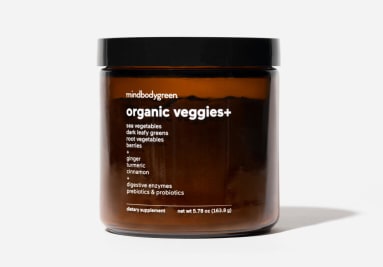What Are Acerola Cherries? + How To Add This Superfruit To Your Diet

Red cherries are a popular summer fruit in the United States and Europe, and acerola cherries are more common in tropical climates. While similar in taste and appearance, acerola cherries are even more nutrient-rich. They're an incredibly antioxidant-rich berry with an impressive amount of vitamin C.
To learn more about these tropical superfruits, mbg reached out to registered dietitians who explain the health benefits and side effects of acerola cherries, plus how to get more in a diet.
What are acerola cherries?
The antioxidant-packed fruit grows on shrubs in warmer, tropical climates, including Central American and Caribbean countries1.
While they can be eaten in their raw, fresh form, they perish quickly. In regions where the shrub does not grow, acerola cherries are more often sold in a powder, supplement, or juice form.
What are the health benefits of acerola cherries?
Acerola cherries are considered a superfruit due to their high levels of ascorbic acid (aka vitamin C), antioxidants, and other phytonutrients, says Mascha Davis, MPH, RDN, author of Eat Your Vitamins.
"They are actually higher than most other food sources of vitamin C," registered dietitian Jess Cording, M.S., R.D., CDN, tells mbg. "United States Department of Agriculture (USDA) data2 notes that they contain about 13 times the amount found in an equivalent serving of oranges."
The vitamin C and other phytonutrients found in acerola cherries have been shown to help manage diseases associated with oxidative stress, Cording explains. Along with vitamin C, acerola cherries3 are high in vitamins A, B1, B2, niacin, albumin, iron, phosphorus, and calcium, one study writes.
Are there any side effects of acerola cherries?
There are generally no side effects of eating a reasonable amount of acerola cherries. However, Davis says very high amounts can cause digestive distress and may lead to kidney stones.
"If you're already on a vitamin C supplement, go slow with the juice and touch base with your doctor if you want to take a powder, extract, or capsule form," Cording adds. "Additionally, if you're allergic to cherries, consult with your doctor as to whether this would be an appropriate choice for you, depending on the severity of your allergy."
When drinking acerola cherries in juice form, Cording says to take the carbohydrate and sugar content into account, as well.
How acerola cherries are used and ways to get more.
"Acerola cherry is most commonly consumed in supplement form as a powder, capsule, or extract, though juice is also available," Cording says. Acerola cherries are often an ingredient in vitamin C supplements.
It can also be found in the antioxidant blend found in mbg organic veggies+ greens powder, along with strawberries, raspberries, blueberries, black currant, acai, and cranberries. This veggies powder is easy to add to snacks, desserts, and smoothies to help manage inflammation and support immune function.*
While acerola cherries can be consumed in their raw, fresh form, Cording says this is less common because of their short shelf life.
Bottom line.
Acerola cherries may taste and look similar to regular red cherries, but they are higher in vitamin C and antioxidants. Their short shelf life makes them more viable in supplement, powder, or juice form. Just remember to be aware of your intake to avoid stomach discomfort or kidney stones.

Abby Moore is an editorial operations manager at mindbodygreen. She earned a B.A. in Journalism from The University of Texas at Austin and has previously written for Tribeza magazine. She has covered topics ranging from regenerative agriculture to celebrity entrepreneurship. Moore worked on the copywriting and marketing team at Siete Family Foods before moving to New York.

